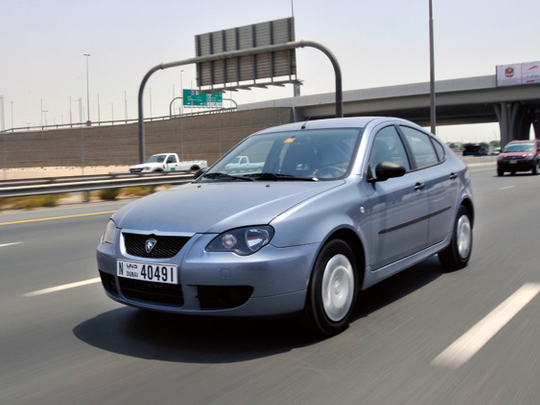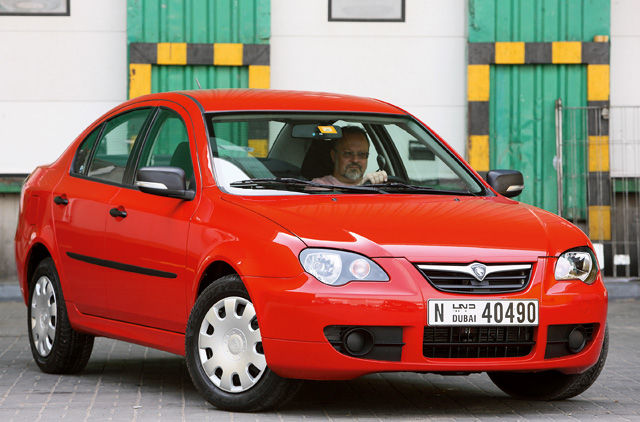
For years, Malaysia's leading carmaker Proton relied on a series of previous generation Mitsubishi-based mid-sized sedans for its core range. In the UK, they were regarded with mild pity by most, and with fierce loyalty by their owners. They may have been lacklustre drives, but those Protons lasted for ever. It is this reputation for basic but reliable motoring that defines the marque today. But things have changed under the surface, and today's Proton is very far indeed from the Lancer-based Wira that it replaces.
First, a bit of context. Hugely popular in their home country, Proton builds more than a dozen models, and has sold more than 3 million cars in 25 nations around the world. What's more, it acquired a share in the iconic British Lotus Group International in October 1996, and increased that stake to 100 per cent in 2003. It was a bold move, and one that benefited both companies. Lotus got much-needed financial stability, and Proton gained access to some of the most skilled handling specialists in the automotive industry.
Now to the present. The GEN-2 is a product of that union, a five-door hatchback developed in conjunction with Norfolk-based sports car manufacturer Lotus. In fact, the GEN-2 was the first fully Malaysian-developed Proton car, intended as the replacement model for the Proton Wira. Following the launch of the GEN-2 on February 8, 2004, Proton continued to sell the Wira, due primarily to the popularity of sedan/saloon vehicles in their home market.
A completely new design, the exterior of the 2011 GEN-2 was styled by Proton's chief stylist Damian Chia. He drew inspiration from the traditional Malay kite (known locally as wau bulan), and the handle of the Malay dagger, the kris, in shaping the grille of the GEN-2. Chia also gave the new car what he describes as "tiger-like eyes" to give the front a more forceful appearance.
The interior was the work of designer Zafruddin Shamsuddin, given a supposedly clean sheet brief. Proton would like us to think that it has a minimalist and modern interior with design cues from its Lotus subsidiary, but this is not where the Lotus link shows most prominently. Instead, you are presented with a fairly basic interior, cloth seats, shiny plastics and a weird radio built into the centre console.
On our very basic ‘fleet spec' model there were too many blanked off switches and buttons, a constant reminder of the toys you didn't get. Material quality was acceptable, though there were some rough edges on such things as the indicator stalk, but there is a surprising amount of space and it is rattle-free. Improved quality materials and assistance from the TUV of Germany have made sure the current GEN-2 can hold its own in a competitive sector of the market.
Keeping it simple
The GEN-2 is powered by a 1.6-litre, 16-valve CAMPRO engine, which produces 110bhp @ 6000rpm. Our car had a simple four-speed auto box, and covered the 0-100kph dash in a lazy 13.5 seconds. Nevertheless, it could hold 120kph comfortably enough, and proved quiet and comfortable at that speed. Road noise from the standard Goodyears was mostly drowned out by the roar of the AC fan, but at least it blew decently cold.
Actually, go back to that Lotus connection. Proton is able to draw on all the skills in its sports car engineering department, and Lotus has worked on a number of Proton cars over the years to improve handling. The Lotus-developed suspension (Macpherson strut and coil spring front, multi-link and coil spring rear) works well, and the GEN-2's general handling and road manners were a pleasant surprise.
Our ‘Base-line' car didn't have ABS, a surprising omission in this day and age, but the importer promises that retail buyers can expect that and much more as standard.
Our test car did have driver and passenger front airbags and front seatbelts with pre-tensioners and load limiters. Buyers of the ‘Medium-line' cars can expect keyless remote entry and central locking, parking sensors, alloy wheels and more when their cars hit the road.
The cabin is spacious with plenty of head and legroom in the front, although rear seat passengers may find that headroom is more restricted by the sloping roofline. The GEN-2 is an easy car to get in and out of - the front doors open to reveal wide access, making it an excellent choice for people with mobility problems.
The seats were firm but comfortable with good under-thigh support. The driver's seat in later cars will be adjustable for height and reach, and the front seats have integrated head restraints. The steering wheel is height and tilt adjustable, but the plastic is unforgiving and feels cheap, an odd mistake to make given that the wheel is probably the most important tactile interface in any car.
In many ways the Proton GEN-2 is a surprising car, a return to basics (or perhaps one that hasn't been burdened with the modern gadgets that overwhelm other modern cars). It is never going to break records for speed or refinement, but it does handle with a degree of finesse you might expect from a car in a league above. It offers a lot of useable space, and given that the package includes free registration and insurance for the first year, is extraordinary value.
The GEN-2 is a hatchback version, but there is an alternative ending to this story, the booted sedan model, the Persona. In theory this is an identical car apart from the rear end, which here has a conventional boot and fixed rear window, likely to be the more popular format in the region.
Interestingly, our test car had more modern instruments than the GEN-2, clear dials that lit up with white numbers on black, and crisp red needles. The radio, too, was better, a proper Blaupunkt unit with USB input.
Strangely, the drive was different too, less eager than the GEN-2, but quieter and more refined.
The gearbox shares the GEN-2's general indecisiveness, sometimes hanging on to a gear until the engine hits the limiter, other times shifting sweetly and early. The differences were more marked than the simple change between hatchback and boot would suggest, and lent the Persona quite a different character.
I would suggest that drivers try both before deciding which suits them better, but the interior would certainly incline me to the slightly more expensive Persona.
Inside info
GEN-2 - Four-door hatchback, front-wheel drive
- Engine: 1600cc four-cylinder
- Power: 110bhp, 148Nm torque
- Performance: 0-100kph 13.5 secs, 185kph max
- Weight: 1,195kg
- Price: Dh42,000
Persona - Four-door sedan, front-wheel drive
- Engine: 1600cc four-cylinder
- Power: 110bhp, 148Nm torque
- Performance: 0-100kph 13.5 secs, 185kph max
- Weight: 1,195kg
- Price: Dh43,000



